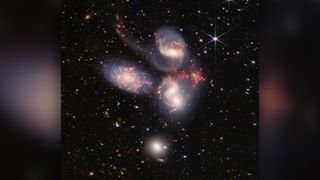Gas cloud 20 times bigger than the Milky Way may have been left by a cosmic intruder, study reveals
The cloud is a 2 million light-year-wide hydrogen stream leading from Stephan's Quintet

Scientists have discovered a gigantic trail of gas drifting out from a quintet of warring galaxies. The mysterious gas cloud — the largest ever seen around a group of galaxies — may have been left behind by a “cosmic intruder,” a new study reveals.
The cloud — an unexplained, 2 million light-year-wide stream of hydrogen gas coming from the galactic group known as Stephan's Quintet — was discovered by the deepest ever scan of the region by the Five-hundred-meter Aperture Spherical Telescope (FAST) in China. Researchers think the gas trail,, could be "tidal debris" formed after the whirling galaxies collided with a large cosmic intruder roughly 1 billion years ago.
Named after its 19th-century discoverer, French astronomer Édouard Stephan, Stephan's Quintet is a group of five galaxies that are "locked in a cosmic dance of repeated close encounters," according to NASA, as they endlessly orbit and pirouette past each other. Sitting around 300 million light-years from Earth, the quintet is the first compact galaxy group ever spotted and has been imaged by numerous telescopes, including the Hubble Space Telescope and the James Webb Space Telescope. Now, new research, conducted with FAST and published Oct. 19 in the journal Nature, has peered 100 times deeper into the galaxy group than ever before, revealing the enormous gas cloud emanating from it.
Related: Can the James Webb Space Telescope really see the past?
"This is the largest atomic gas structure ever found around a galaxy group," Xu Cong, the study lead author and an astronomer at the National Astronomical Observatories of the Chinese Academy of Sciences, said in a statement.
The gas cloud was formed roughly 1.5 billion years ago, when an unknown interaction stripped atomic hydrogen from the galaxies and sprayed it about. The researchers blame t one or more fast-moving galaxies colliding with the quintet, and they have even identified a possible culprit — the galaxy NGC 7320a, which is currently zipping through the cosmos at almost 15 million mph (24 million km/h).
"A hypothetical scenario for the formation of the diffuse feature is that NGC 7320a … passed through Stephan's Quintet approximately 1.5 billion years ago … and pulled out from one of the core member galaxies of Stephan's Quintet a tidal tail, which developed into the diffuse feature we see now," the astronomers wrote in the study.
Sign up for the Live Science daily newsletter now
Get the world’s most fascinating discoveries delivered straight to your inbox.
Alternatively, the gas cloud could have been stirred up by a head-on collision between one of the quintet's galaxies and another roaming galaxy, such as the galaxy Anon 4. A head-on collision would have created a shock wave that pushed the hydrogen out into an expanding halo around the group, the researchers wrote. Another possibility is that the trail might not be from a galactic collision at all, but the leftovers of the primordial gas cloud from which one or more of the quintet galaxies formed.
Regardless of what caused the trail, scientists are also unsure how the gas has stuck around for so long. Astronomers usually don't expect gas clouds to survive for more than 500 million years because exposure to ultraviolet radiation from stars tends to ionize them until they dissipate. The researchers think the low-density cloud may be leaking energy absorbed from the stars out into its surroundings, but understanding how this would happen requires further study. The answer might provide insights into how galaxies are born and how they grow.

Ben Turner is a U.K. based staff writer at Live Science. He covers physics and astronomy, among other topics like tech and climate change. He graduated from University College London with a degree in particle physics before training as a journalist. When he's not writing, Ben enjoys reading literature, playing the guitar and embarrassing himself with chess.
